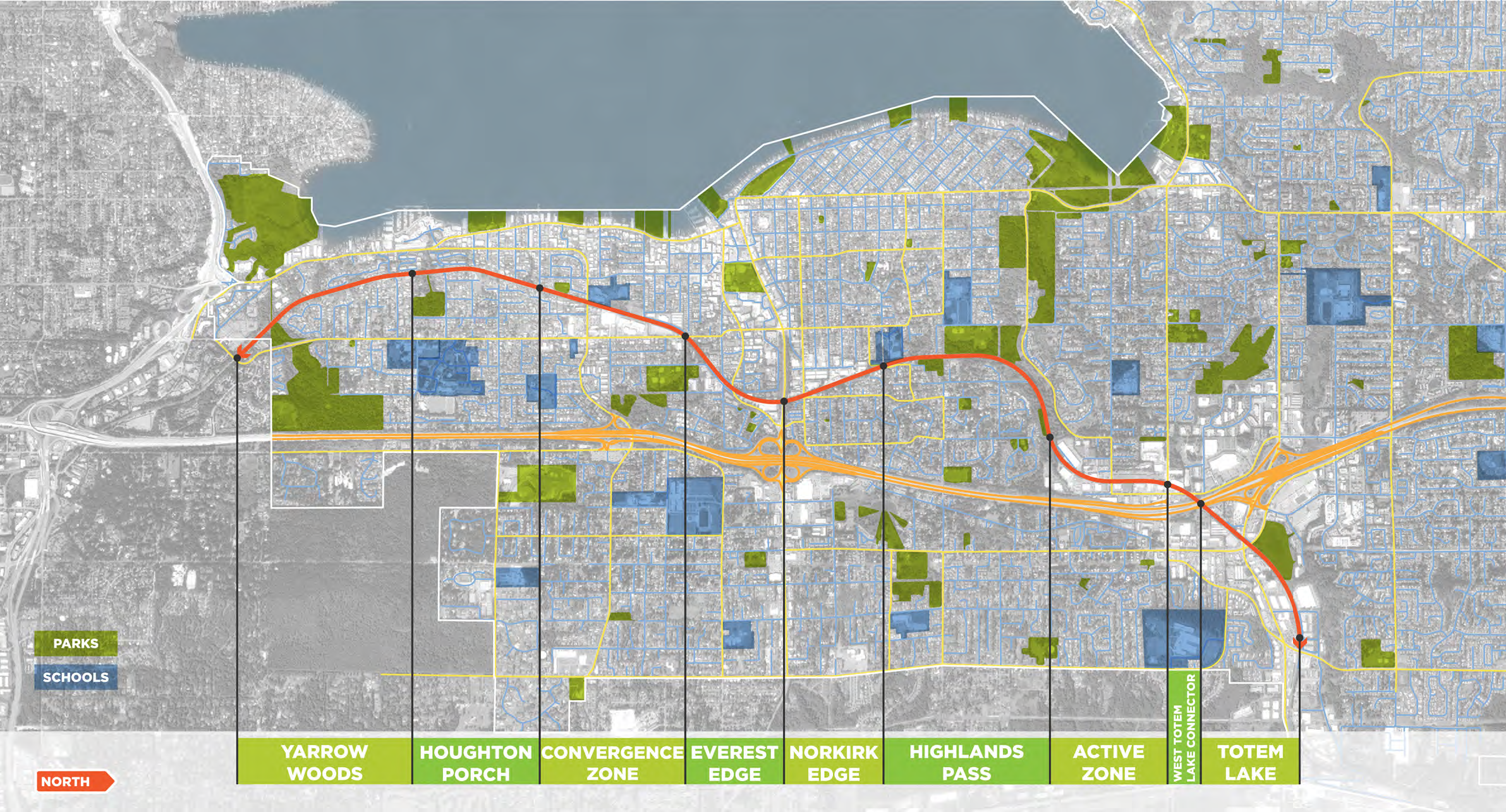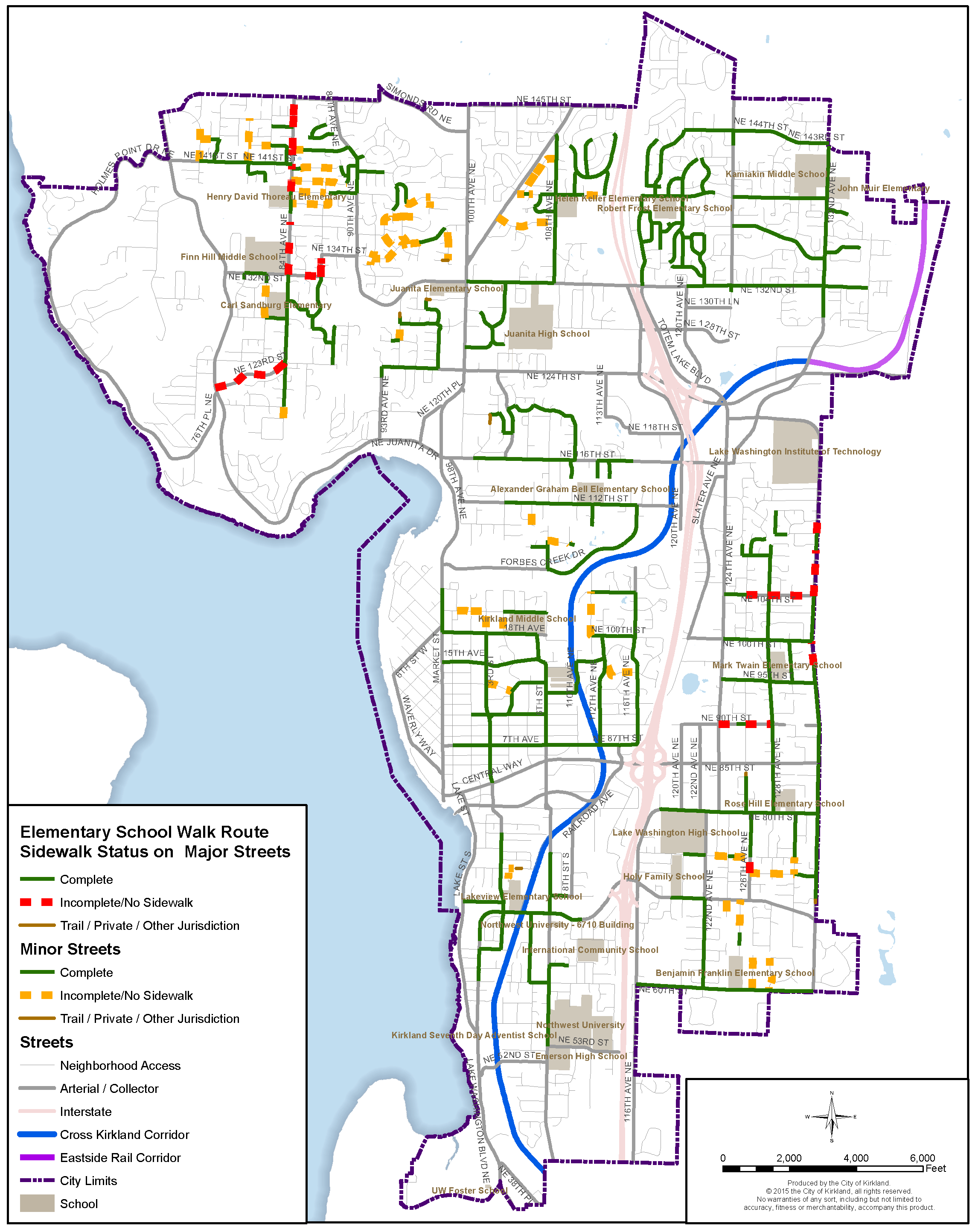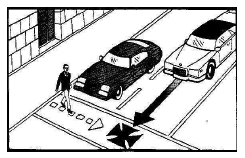2. WALKING
Background
Walking supports a livable community through increased interpersonal interaction, commerce, and health. Pedestrians, including people who use wheelchairs or other mobility aids, are an important priority on Kirkland’s transportation network because every traveler is a pedestrian at some stage of their trip, regardless of travel mode.
Walking has long been a cornerstone of the transportation system in Kirkland as evidenced by the creation of lakefront walkways, use of innovative crossing treatments and, most recently, through the purchase of the Cross Kirkland Corridor for use as a multimodal transportation corridor. Because of an emphasis on walking facilities around schools, improvements have been made at almost every school in Kirkland during the past few years.
Despite these efforts there is more to be done. I-405 is a barrier to walking. Too many busy streets do not have sidewalks. Crosswalks need upgrades and there are still areas around schools, parks and commercial areas that need improvements. Better lighting, separation from traffic, wayfinding, and facilities to help those who rely on curb ramps and other aids are also areas where improvement is needed. Safe and simple walking connections to reliable public transit is also needed.
Focusing on what makes a great walking environment – accessibility, safety, comfort, clarity, completeness – and applying these concepts throughout Kirkland is fundamental to this goal. Two places in particular, the shores of Lake Washington and the Cross Kirkland Corridor, offer the opportunity to create places that are both multimodal transportation facilities and spaces offering truly remarkable experiences for walking.
Goal T-1: Complete a safe network of sidewalks, trails and improved crossings where walking is comfortable and the first choice for many trips.
Policy T-1.1: Improve the safety of walking in Kirkland.
Protecting pedestrians is one of the most important values held by Kirkland’s residents and also by the current City Council, City Councils of the past, and, it is safe to assume, City Councils of the future. Therefore this policy is foundational to the planning of the transportation system.
Data necessary for an accurate and cost-effective safety evaluation is critical to improving safety and must be gathered over time. Rate-based measures like crashes-per-unit-of-pedestrian-volume are more helpful than simply the number of pedestrian crashes because they help prioritize where crash countermeasures are most needed.
Meaningful increases in pedestrian safety require a multi-disciplinary, multi-agency approach addressing more than the implementation of engineering solutions and simply keeping track of the number of crashes involving pedestrians. Washington State’s Target Zero Campaign and other programs throughout the U.S. are examples of this approach. Such efforts should be adopted fully by the City of Kirkland. (See Policy T-0.1.)
Policy T-1.2: Identify and remove barriers to walking.
All the policies and actions associated with Goal T-1 are associated in one way or another with removing barriers to walking. This policy serves not only as the basis for the removal of specific barriers but also the policy by which general actions are supported.
Kirkland’s Active Transportation Plan (ATP) is a means for coordinating pedestrian needs on a more detailed level than is done here and the ATP should be updated regularly, ideally at least every five years.
Common physical barriers to walking include vegetation that extends into walkways from public and private property. Solid waste receptacles are a common source of obstructed walkways because often there is no place for their storage besides sidewalks. Because of our long fall and winter evenings, lighting is a necessary feature in the pedestrian network.
Making facilities accessible to all users is a large and important undertaking. The City of Kirkland carefully scrutinizes new construction and maintenance activities to make sure that those projects meet the most current standards for accessibility. There is a large fraction of existing facilities that need comprehensive review and possible mitigation. Those mitigations represent a sizable investment relative to the amount of funding that has traditionally been available for capital projects.
Projects that remove barriers to historically underserved populations such as low income and senior populations should be prioritized. Often these communities have relatively low auto-ownership rates and therefore draw substantial benefit from pedestrian improvements. Young people should be considered in the design of the pedestrian network for all types of trips, not just for the journey to school.
Because it bisects the City from north to south, I-405 is an effective barrier to pedestrian travel. This barrier should be made more permeable wherever feasible. This could include new bridges and improved pedestrian facilities at interchanges.
Connections between cul-de-sacs and dead end streets that remove barriers to pedestrian travel should be planned and implemented. Connections to Lake Washington are of particular importance. Many of these connections are built with new development. (See Policy T-5.6.)
Policy T-1.3: Make getting around Kirkland on foot intuitive.
A complete wayfinding system for pedestrians complements and makes a sidewalk and trail network more functional. Wayfinding systems that move beyond signing only, for example those that integrate web-based systems, should be explored. Up-to-date mapping that is convenient for those traveling by foot is also beneficial to activating neighborhoods where people can walk regularly for daily tasks. Making this information available in multiple formats and across multiple platforms will increase its usefulness.
Policy T-1.4: Prioritize, design and construct pedestrian facilities in a manner that supports the pedestrian goal and other goals in the TMP.
Safe and convenient walkways of the appropriate size are a foundation for pedestrian activity. Kirkland’s existing codes call for sidewalks on both sides of almost all streets. Because of the high cost to construct sidewalks everywhere, they are missing in many points of Kirkland’s system; it is important that clear priorities are used to assign funding to the most worthy projects first. Locations should be prioritized using the following factors:
• Improve Safety – prioritize locations based on crash history and indicators of crash risk like adjacent street auto volume, speed and number of lanes.
• Link to Land Use – choose sidewalks that expand and enhance walkability and places where current pedestrian volumes are high.
• Connect to the Cross Kirkland Corridor – make numerous strong links to the CKC.
• Make Connections – give high priority to projects that fill gaps by connecting existing sidewalks.
• Connect to Transit – complete walkways that allow easy access to transit, particularly regional transit.
• Community Input – because of the scale of pedestrian projects, gathering the on-the-ground knowledge through community input is particularly important in selecting pedestrian projects.
• Cost/Likeliness to Receive Grant Funding – projects that have lower cost or that are good candidates for grant funding should generally have a higher priority. However, caution must be exercised so that high cost, high value projects are also considered.
Design of sidewalks should include features that make them safe and comfortable. The need for planter strips and wider sidewalks increases where land use is more intense and where the number of auto lanes and speeds on adjacent streets are greater. On street parking can also serve as a buffer between pedestrians and moving vehicles.
Policy T-1.5: Develop world-class walking facilities along the Cross Kirkland Corridor with ample connections to the rest of Kirkland. Consider creating a plan for a promenade along portions of the shore of Lake Washington.
Kirkland is fortunate to have two walking environments that distinguish it from many other cities. The first is the 5.75-mile-long Cross Kirkland Corridor (CKC), part of the 42-mile Eastside Rail Corridor. The corridor Master Plan recognizes that the corridor is at once a place for both transportation and recreation, a place to go through and a place of activity in its own right. Realizing the Master Plan’s multimodal vision will result in a corridor of the highest value to the pedestrian network and to the community.
The second environment of note is the shore of Lake Washington, south of downtown Kirkland, a popular spot for recreational walking. Like the CKC, it can be imagined as the site of a richer walking experience; not only a place to walk through, but a lively gathering place that enhances the entire community. A planning study would be a logical first step in evaluating if and how the space along the lake could and should be used.
Below: The CKC Master Plan considers the corridor in a series of zones, each with its own character.
Policy T-1.6: Make it safe and easy for children to walk to school and other destinations.
Because of the many benefits of walking, encouraging children to walk to school is a long standing priority of the Kirkland City Council and a goal in the current Active Transportation Plan. As a result of this focus, the number of school walk routes with sidewalks has steadily increased. Completion of improved walkways on all school walk routes is an ultimate objective. Paved paths that are separated from auto traffic with a planter strip are considered complete. Areas without sidewalks or where walkers are separated from auto traffic by an extruded curb are not considered complete. Within the realm of school walk routes, projects should be prioritized based on the factors in Policy T-1.4.
The City has adopted and maintains a set of elementary school walk routes. In order to get substantial numbers of children to walk to school however, more than walk routes with sidewalks are needed. A multi-dimensional approach that identifies and systematically removes barriers to walking is necessary. This may include programs within schools that promote walking like “walking school buses.” Planning must address the safety concerns of parents. The City should encourage, coordinate and be a resource for improving school walking programs but should not necessarily be responsible for their implementation.
In addition to travel to and from school, youth should be encouraged to walk to other activities; for example to a friend’s house or to run errands. The same principles that support walking to school should be used to encourage walking for these other purposes.
Figure T-17: School Walk Routes
Policy T-1.7: Improve street crossings.
Street crossings are critical to the success of a pedestrian network. Kirkland has a history of innovation in treatments at uncontrolled (crosswalks where vehicles are not required to stop) crossing locations and this should continue. Rapid flashing beacons or other state of the art devices should be used to enhance pedestrian visibility. Best practices and research1 should be used to guide decisions.
|
3 Factors That Most Influence Crosswalk Safety: |
|
|---|---|
|
1. |
Number of Lanes. Multi-lane streets can leave pedestrians vulnerable to the “double threat” crash where one vehicle stops, the pedestrian begins to cross and the other vehicle, not seeing the pedestrian, proceeds through the crosswalk. |
|
|
|
|
2. |
Traffic Volume. When the number of cars increases more protection is needed at a crosswalk. |
|
3. |
Traffic Speed. It’s intuitive that increased traffic speeds lead to higher pedestrian risk. |
|
All three of these factors interact to determine what’s needed at a particular crosswalk. As lanes, speed and volumes increase, a marked crosswalk alone is less appropriate and more protection is needed. |
|
The pedestrian flag program should be continued at crosswalks where volunteers are available to help stock and maintain the flags. Program improvements that increase flag usage should be sought.
Prioritization for street crossing improvements should be similar to those used for sidewalk projects:
• Improve Safety – within the context of a Vision Zero program, consider crash history and indicators of crash risk such as vehicle speed.
• Link to Land Use – prioritize crossings on routes with sidewalks that expand and enhance walkability or that otherwise help achieve Kirkland’s land use goals. Improvements in the Totem Lake and Greater Downtown Urban Centers should be given priority.
• Connect to the Cross Kirkland Corridor – improve crossings on routes that lead to or are near the CKC.
• Connect to Transit – give priority to crosswalks that allow easy access to transit, particularly regional transit, including near stops or at locations where multiple routes converge.
• Community Input – continue to involve the community in deciding where crosswalks should be located and improved.
• Cost/Likeliness to Receive Grant Funding – prioritize projects that have lower cost or that are good candidates for grant funding, but apply caution so that high cost, high value projects are also included.
Medians have been proven to have high value in improving pedestrian safety, and should be given special consideration at multi-lane locations where vehicle volumes are high. Adequate lighting and accessibility are other features that are a basic requirement at any crossing location. Because turning vehicles pose special risk to pedestrians, the proximity of crosswalks to turning movements should be considered. The bulk of pedestrian crashes occur at intersections and turning vehicles are often involved. Features that reduce pedestrian exposure to risks at signalized intersections should be incorporated into the design of all intersections.
Traffic signal operation should regularly implement features that make crossing easier and safer for pedestrians.
Figure T-18: Possible Crosswalk Treatment Candidates
For example Safety Effects of Marked Versus Unmarked Crosswalks at Uncontrolled Locations Final Report and Recommended Guidelines, FHWA, 2005.





